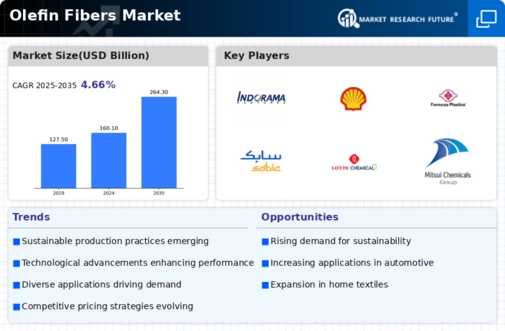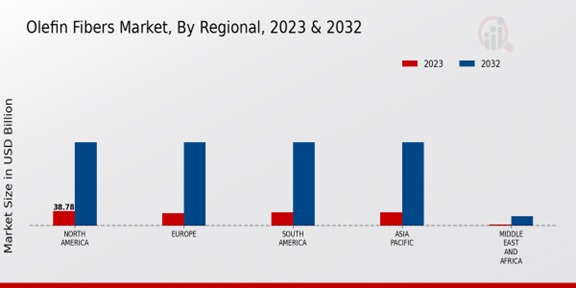Market Growth Projections
The Global Olefin Fibers Market Industry is poised for substantial growth, with projections indicating a market value of 160.1 USD Billion in 2024 and an anticipated increase to 264.3 USD Billion by 2035. This growth trajectory suggests a robust compound annual growth rate (CAGR) of 4.66% from 2025 to 2035. Such projections reflect the increasing adoption of olefin fibers across various sectors, driven by factors such as sustainability, technological advancements, and expanding applications. The market's upward trend indicates a favorable environment for stakeholders, presenting opportunities for innovation and investment in olefin fiber technologies.
Rising Demand for Sustainable Materials
The Global Olefin Fibers Market Industry is experiencing a notable shift towards sustainable materials, driven by increasing consumer awareness regarding environmental issues. As industries seek eco-friendly alternatives, olefin fibers, known for their recyclability and lower environmental impact, gain traction. This trend is particularly evident in the automotive and textile sectors, where manufacturers are incorporating olefin fibers into their products. For instance, the automotive industry is projected to utilize olefin fibers in interior components, enhancing sustainability while maintaining performance. This growing demand aligns with the industry's projected growth, with the market expected to reach 160.1 USD Billion in 2024.
Expanding Applications Across Industries
The versatility of olefin fibers is propelling their adoption across diverse industries, thereby driving the Global Olefin Fibers Market Industry. From automotive interiors to home furnishings and industrial applications, olefin fibers are increasingly recognized for their durability, moisture resistance, and ease of maintenance. For instance, the use of olefin fibers in outdoor furniture and carpets is gaining popularity due to their ability to withstand harsh weather conditions. This expanding application range not only enhances market penetration but also supports the overall growth of the industry, with projections indicating a market value of 264.3 USD Billion by 2035.
Increased Focus on Lightweight Materials
The shift towards lightweight materials in various sectors is significantly impacting the Global Olefin Fibers Market Industry. Industries such as automotive and aerospace are increasingly prioritizing weight reduction to improve fuel efficiency and performance. Olefin fibers, known for their lightweight properties, are becoming a preferred choice for manufacturers aiming to meet these demands. For example, the automotive sector is incorporating olefin fibers in vehicle interiors and components, contributing to overall weight reduction. This trend not only enhances vehicle performance but also aligns with environmental regulations. As a result, the demand for olefin fibers is expected to rise, further driving market growth.
Technological Advancements in Fiber Production
Technological innovations in the production of olefin fibers are significantly influencing the Global Olefin Fibers Market Industry. Advances in manufacturing processes, such as improved polymerization techniques and spinning technologies, enhance the quality and performance of olefin fibers. These innovations not only increase production efficiency but also reduce costs, making olefin fibers more competitive against other materials. For example, the introduction of advanced extrusion methods has led to the development of high-tenacity fibers, which are increasingly utilized in various applications, including industrial textiles and geotextiles. Such advancements are likely to contribute to the market's growth trajectory, with a projected CAGR of 4.66% from 2025 to 2035.
Growing Urbanization and Infrastructure Development
Urbanization and infrastructure development are key factors influencing the Global Olefin Fibers Market Industry. As urban areas expand, the demand for construction materials, including olefin-based products, rises. Olefin fibers are increasingly utilized in geotextiles and construction fabrics due to their strength and durability. This trend is particularly evident in emerging economies, where rapid urbanization drives the need for efficient construction solutions. The integration of olefin fibers into infrastructure projects not only enhances performance but also contributes to sustainability goals. This growing demand is expected to bolster the market's growth, aligning with the overall upward trajectory of the industry.






















